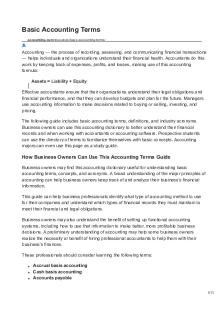Upload-cfi-ratios - Accounting PDF

| Title | Upload-cfi-ratios - Accounting |
|---|---|
| Course | Accounting/Finance Core |
| Institution | St. Mary's University (Texas) |
| Pages | 2 |
| File Size | 78.9 KB |
| File Type | |
| Total Downloads | 4 |
| Total Views | 152 |
Summary
Accounting...
Description
SIMPLE ACCOUNTING-SECRETS – 9
RATIOS
Since BUCKS is common to all currencies, the same may have been used. Please substitute the word with the currency of your country Regret, I am nor computer-savvy. Kindly excuse errors in formatting. There are five types of ratios. They are Profitability ratio Liquidity ratio Activity ratio Solvency ratio Leverage ratio Briefly put Profitability ratios, as the name suggests, indicate the profitability of a firm. For example, firms A and B with an identical investment of, say, 10,000 bucks, make a profit of 1000 and 1500 bucks respectively. Firm B has a better profitability ratio. Liquidity ratios indicate the availability of funds at hand for running the business. For example, firm A has sales of 100,000, all on credit basis leaving the firm with no cash on hand. Firm B has sales of just 10,000, but all for cash. Firm B has a better liquidity ratio.
Let us assume both the firms A and B have identical turnover. Both sell, every year, goods costing 12,000 bucks for 24,000. Firm A purchases goods worth 12,000 bucks at the beginning of the year itself and starts selling the same. But firm B purchases goods worth 1,000 bucks every month, 12 times a year, and sells them. Here, firm B has a greater turnover ratio (12 times) than firm A (one time). A large firm making huge losses can still manage because it may have a lot of assets like buildings, land, vehicles, etc. In case of a crisis, it can sell some of its assets and pay off the dues. But a smaller firm, though making reasonable profits, may not have assets like building, etc. In case of a crisis, it may not have the capacity, also called as solvency, to manage. This is solvency ratio. Leverage ratio helps in balancing various assets and liabilities in the best interests of the firm. For example, investments in the business need not all be owner’s capital even though he can afford it. He may invest part of the amount required and borrow the rest from a bank because he may be wanting to invest some money in land, gold, etc. keeping in mind, the future security. This is leverage ratio. Each of the above ratios has sub-categories and that is separate discussion....
Similar Free PDFs

Accounting
- 12 Pages

Accounting-concepts - accounting
- 4 Pages

Accounting
- 14 Pages

Revaluation accounting
- 13 Pages
Popular Institutions
- Tinajero National High School - Annex
- Politeknik Caltex Riau
- Yokohama City University
- SGT University
- University of Al-Qadisiyah
- Divine Word College of Vigan
- Techniek College Rotterdam
- Universidade de Santiago
- Universiti Teknologi MARA Cawangan Johor Kampus Pasir Gudang
- Poltekkes Kemenkes Yogyakarta
- Baguio City National High School
- Colegio san marcos
- preparatoria uno
- Centro de Bachillerato Tecnológico Industrial y de Servicios No. 107
- Dalian Maritime University
- Quang Trung Secondary School
- Colegio Tecnológico en Informática
- Corporación Regional de Educación Superior
- Grupo CEDVA
- Dar Al Uloom University
- Centro de Estudios Preuniversitarios de la Universidad Nacional de Ingeniería
- 上智大学
- Aakash International School, Nuna Majara
- San Felipe Neri Catholic School
- Kang Chiao International School - New Taipei City
- Misamis Occidental National High School
- Institución Educativa Escuela Normal Juan Ladrilleros
- Kolehiyo ng Pantukan
- Batanes State College
- Instituto Continental
- Sekolah Menengah Kejuruan Kesehatan Kaltara (Tarakan)
- Colegio de La Inmaculada Concepcion - Cebu











